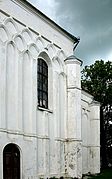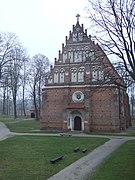Belarusian Gothic
Belarusian Gothic , Belarusian беларуская готыка belaruskaja hotyka , Russian белорусская готика belorusskaja gotika , is a style name for some buildings that were built in the 15th and 16th centuries, mostly in the first half of the sixteenth century in Lithuania and in what is now Southeastern Belarus eastern Poland were erected. The name is not without controversy and is also seen as an expression of Belarusian nationalism.
In addition to typical Gothic style features, the buildings also have those that are not included in the Gothic style in Central and Western Europe.
Conditions of origin
Since the baptism of the Kiev Grand Duke Vladimir I and the Christianization of the Empire of Kiev that began, the architecture of the Russian lands has also been strongly influenced by Byzantine art . The collapse of the Kievan Rus and the subjugation of large parts by the Mongols and the Golden Horde brought devastation and hardship over the country.
In the course of the 13th century and the first years of the fourteenth, the Russian principalities in what is now Belarus were gradually subjugated by the Grand Duchy of Lithuania , which emerged in opposition to the state of the German Order , remained pagan for a long time and became a great power in the 14th century has been. This state had a Lithuanian aristocratic class, but Lithuanians were the common people only in the north-west. Overall, the majority of the population was Slavic , including the southern and eastern nobility, which originally went back to the Rus . The official language of the Grand Duchy was Ruthenian .
With the personal union between Poland and Lithuania ( Władysław II. Jagiełło ) concluded in 1386 , there was an increasing opening to the west and growing prosperity, especially after the final victory of the interconnected states over the religious state in 1466 ( Second Peace of Thorn ).
The Gothic architectural style of entrance spread to the Slavic parts of Lithuania at a time when it was superseded by the Renaissance in Central Europe and had long since been superseded in Southern Europe.
In the south-east of today's Republic of Lithuania, which did not once belong to Rus, the conditions in the 16th century were similar to those in today's Belarus. Accordingly, there are almost as many examples of this style there. The oldest by far is the Cathedral of the Assumption of Our Lady in Vilnius , built in 1346, when the Renaissance had not yet arrived in Central Europe, and in the Lithuanian Empire only the Ruthenian- speaking population was Christian. Instead to speak of "Lithuanian Gothic" is still not advisable, because of the religious background and because there are other variants of the Gothic in Lithuania . The term “Ruthenian Gothic” is hardly found.
Designs
St. Boris and Gleb in Nawahrudak , south wall
St. Michael in Hnesna , 1524-1527
Mir Castle , 16th century
As can be easily explained from the development situation, the "Belarusian Gothic" is a transitional style from forms of Byzantine architecture , the late Gothic and the Renaissance .
- Material: Some of the buildings are similar to the north German brick Gothic , others are completely plastered.
- Arches: The church windows predominantly have pointed arches. There are also late Gothic console lintels . However, blind arcades and arched friezes have predominantly round arches.
- Vaults: Most of the churches have the typical Gothic ribbed vaults . But there are also heavy groin vaults , such as those found in Central Europe in the Romanesque period , much longer in Byzantine and Russian architecture.
- Structure: Most of the churches are fortified churches . Some of these have a particularly distinctive character, with a short nave and four small corner towers. Others have the normal tall bell tower on the west gable.
swell
- Rainer Lindner: Historians and rule: nation building and history politics in Belarus in the 19th and 20th centuries. Verlag Oldenbourg, 1999, ISBN 3-486-56455-2 , p. 256, II. Nation and history in Stalinism → 3. Rivalry of myths
- Andreas Böhm, Maryna Rakhlei: Travel Guide Belarus: With Minsk, Brest, Hrodna, Homel, Mahiljoŭ and Vicebsk. Trescher Verlag, 2015, ISBN 978-3-89794-271-4 , p. 190 Čarnaŭčycy
- Archives of Belarus, Church Architecture.
- Беларуская готыка ў пабудове культавых будынкаў XV-XVI стст. Belorussian Gothic in religious buildings from the 15th and 16th centuries. (in Belarusian, heavily illustrated)
- Belarus - culture. on: www.europa-experte.de






